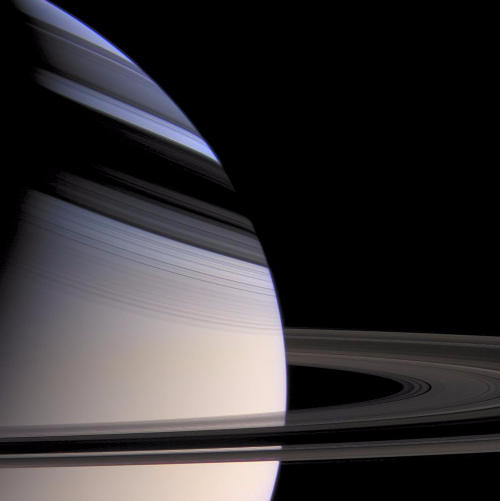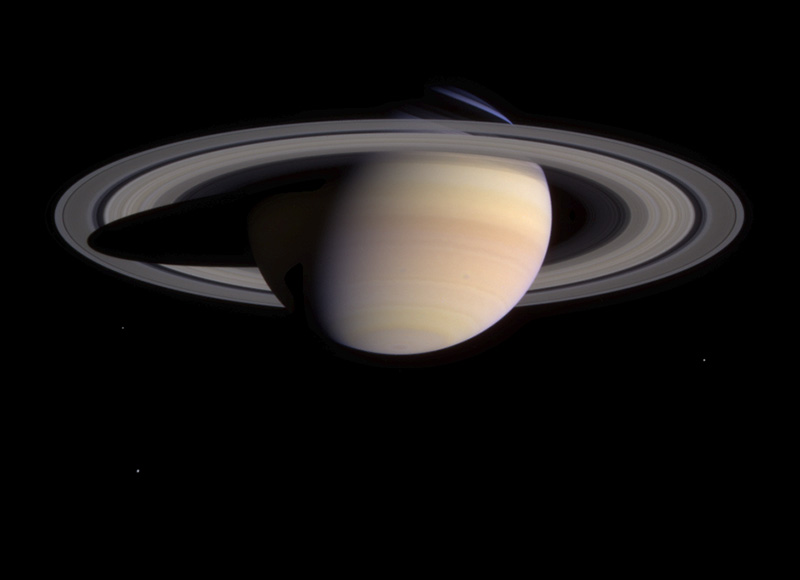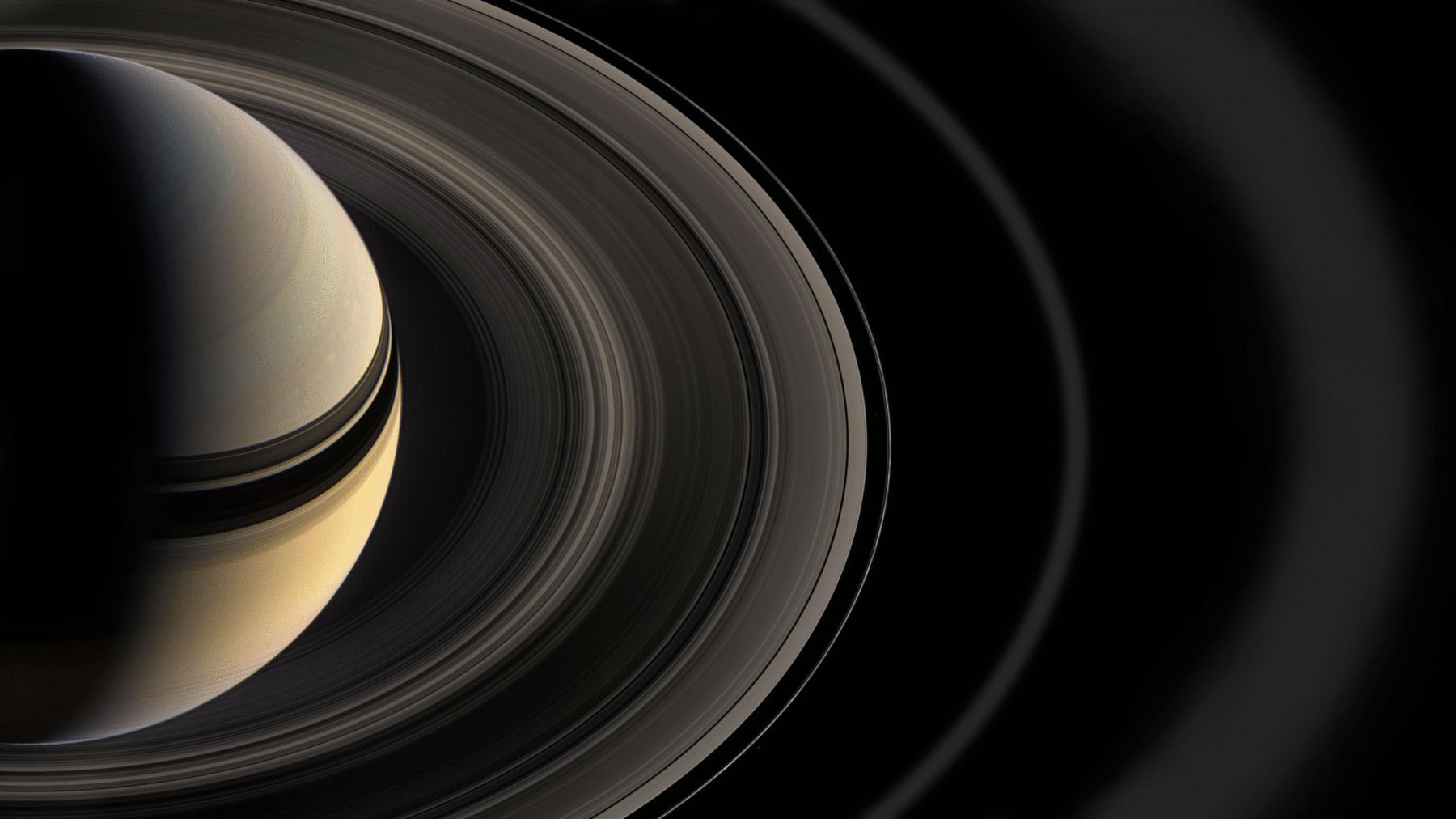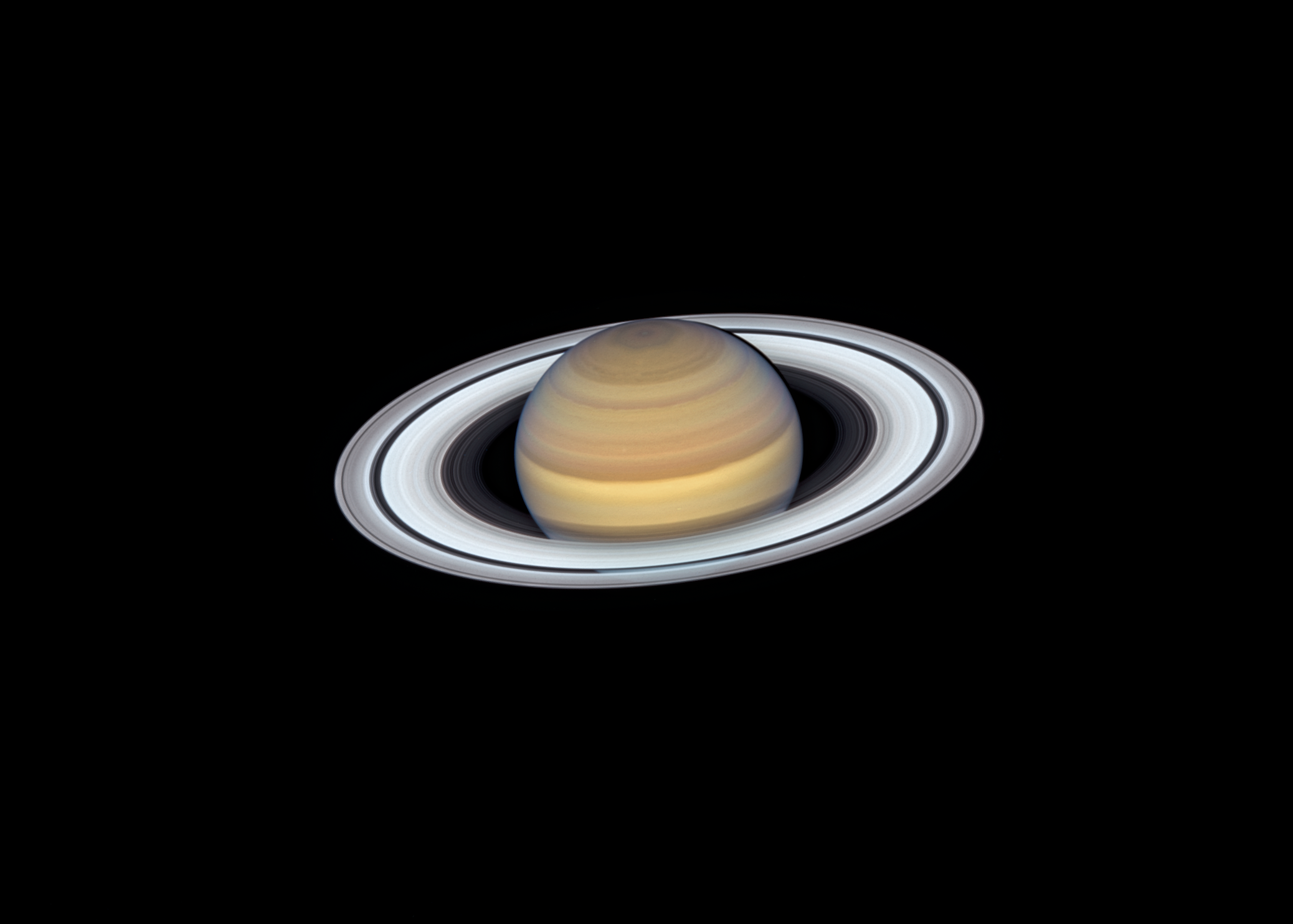Saturn Rings: Overview
Scientists had never before studied the size, temperature, composition and distribution of Saturn’s rings from Saturn orbit. Cassini captured extraordinary ring-moon interactions, observed the lowest ring-temperature ever recorded at Saturn, discovered that the moon Enceladus is the source for Saturn’s E ring, and viewed the rings at equinox when sunlight strikes the rings edge-on, revealing never-before-seen ring features and details.
Key Points
◆ The particles that make up Saturn’s rings range in size from smaller than a grain of sand to as large as mountains.
◆ Cassini found that water jets from the moon Enceladus provide much of the material in Saturn’s E-ring, a diffuse ring outside of the bright, main rings.
◆ Cassini studied features in Saturn’s rings called “spokes,” which can be longer than the diameter of Earth. Scientists think they’re made of tiny icy particles that are lifted by an electrostatic charge and only last a few hours.
◆ During Saturn's equinox, when the rings face the Sun edge-on, Cassini watched ring particles produce elongated shadows that revealed unexpectedly immense ring chunks that measured miles (kilometers) in size.
No other planet in our solar system has rings as splendid as Saturn’s. They are so expansive and bright that they were discovered as soon as humans began pointing telescopes at the night sky.
Galileo Galilei was the first person known to view the heavens through a telescope. He secured his status as an astronomical giant when he discovered Jupiter’s four largest moons in 1610. Saturn is nearly twice as far from the Sun as Jupiter, and yet Saturn’s rings are so big and brilliant that Galileo discovered them the same year he spotted Jupiter’s moons.
In the 400 years since Galileo's discovery, the rings have become Saturn’s telltale feature and are perhaps the most recognized characteristic of any world in our solar system. Cassini spent more than a decade examining them more closely than any spacecraft has before.
Along with Saturn and its moons, the rings are one of the three primary components of the Saturn system. The rings are generally about 30 feet (10 meters) thick or so and are almost completely composed of billions (if not trillions) of chunks of water ice, ranging in size from smaller than a grain of sand to the size of a mountain.
The Cassini mission helped scientists understand some of the rings’ strange behaviors and observe some new ones.
Ring Exchange

To better understand the size and distribution of ring particles, as well as what they’re made of, Cassini studied how the light of distant stars changes when passing through the rings, and how our own star’s light reflects off of them. Cassini watched some of Saturn’s moons steal ring particles, and other moons contribute particles to the rings.
Cassini found that much of the material for Saturn's E-ring—a diffuse ring outside the bright, main rings—comes from the moon Enceladus, which is venting icy particles and gas into space as it orbits Saturn. The spacecraft also observed that most of Saturn’s inner moons orbit within rings (some partial and some complete) made of particles blasted off the moons’ own surfaces by micrometeoroid impacts.
Cassini also discovered features that look like propellers, which are sometimes several thousand miles (kilometers) long. The spacecraft’s instruments first observed the formations in 2006. The propellers are produced by the gravitational influence of moonlets, lumps of ring material that are estimated to be half a mile (around 1 kilometer) in diameter, which is smaller than a moon but larger than individual ring particles. The moonlets launch the surrounding ring particles hundreds of feet (meters) above and below the ring, producing the features Cassini imaged.
The ring particles are kicked up in the same way that a moving boat creates wake. The ring particles nearer Saturn move faster than the moonlet while those farther from Saturn move slower than the moonlet, and the interaction is gravitational, causing wake to form both behind and in front of the moonlet as it orbits. “It’s like water is moving in two different directions around the moonlet,” said Linda Spilker, project scientist for the Cassini mission. (But while they resemble propellers, they don’t actually rotate.)
Scientists had some of Cassini’s greatest ring-related revelations after it had completed its four-year primary mission, when the spacecraft was at Saturn for a common celestial event. On Aug. 11, 2009, Cassini became the only spacecraft ever to give scientists an up-close view of Saturn’s rings during the planet’s equinox.
A Planet on Edge

Like Earth, Saturn’s axis of rotation is tilted. For half of a Saturn year, the ringed planet appears to bow toward the Sun, which then illuminates the top of the rings. For the other half of the year, Saturn appears to lean back, and the Sun illuminates Saturn’s south pole and the bottom of the rings. However, for two brief periods in each of Saturn’s orbits about the Sun, the ring edge points not below or above the Sun, but directly at it. This event, called an equinox, gives Saturn’s northern and southern hemispheres equal amounts of sunlight for a brief time. But Saturn takes about 30 Earth-years to orbit the Sun, so its equinox happens only once every 15 years.
In the same way that a tree at sunset can have a shadow many times longer than the tree’s actual height, Saturn’s equinox produced shadows that magnified ring features that have been too subtle to observe. “We wanted to see if the rings were warped,” Spilker said. “They’re not.” But Cassini observations showed that, in places, Saturn’s rings are far less smooth than scientists thought.
Countless icy clumps in the rings cast great shadows upon the rings. Scientists thought they’d be measuring the features in feet (or meters) but found that the largest shadow-casting features were miles (kilometers) above the surrounding ring particles. Some of the clumps and bumps were as tall as the Rocky Mountains.
During equinox Cassini also monitored the temperature of the rings with an infrared spectrometer because temperature helps scientists understand the composition, size, shape and other characteristics of ring particles. Because sunlight was hitting the rings on their edge rather than on their broad face, temperatures in the rings dropped lower than anyone had recorded there before. Cassini saw the A-ring, for example, cool down to minus 382 degrees Fahrenheit (minus 230 degrees Celsius).
In addition, Cassini used the equinox to observe some known phenomena that are poorly understood. One of those features are the "spokes." First seen by the Voyager spacecraft in the 1980s, the spokes are so named because they are finger-like, or wedge-like, radial features in Saturn’s rings that rotate along with the rings, reminiscent of the spokes in a wheel.

The spokes are believed to be made of tiny ice particles that are lifted above the surface of the rings by an electrostatic charge, the way a statically-charged balloon held over a person’s head will lift their hairs, but on an astounding scale. Spokes can be longer than 10,000 miles (16,000 kilometers), greater than the diameter of Earth. But despite their size, spokes can come and go quite quickly. They can form in the time it takes you to eat breakfast and then disappear before you sit down for lunch.
The spokes were unseen from 1998 until 2005, the year after Cassini entered Saturn orbit, which surprised scientists. And in 2008 the spokes appeared again in full, and Cassini captured images, some of which were strung together into a video.
Spokes, clumps, propellers, moonlets, rings that form moons and moons that make rings – one can only guess how Galileo would have reacted had he been able to see Saturn’s puzzling rings as Cassini, and all the world, can now see them.






